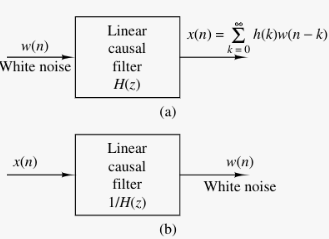Resources: page=845
12.2 - Innovations Representation of a Stationary Random Process
Resources: page=857
Idea: A random Wide-sense stationary process can be represented as the output of a causal and causally invertible linear system excited by a white noise process.

Here, is called a noise whitening filter, and its output, is called the innovations process associated with the stationary random process .
12.2.1 Rational Power Spectra
Given that is a rational function, and the Power Density Spectrum (PDS) of a random process, , and that the roots of and fall inside the unit circle, then we can express in the following way:
Where is the filter coefficients that determines the location of the zeros, and determines the location for the poles.
is a causal, stable and Minimum-Phase linear system.
This gives us
These are the three specific cases we distinguish between depending on the values of and :
Autoregressive, Moving Average (ARMA) process
12.2.2 Relationships Between the Filter Parameters and the Autocorrelation Sequence
We can write the stochastic Autocorrelation of as
Where is the Crosscorrelation sequence between and at lag .
Giving us the following equation for a general Autoregressive, Moving Average (ARMA) process.
This is very important, as we now have a linear relationship between and . We can now use the Yule-Walker equations
The simultaneous joint probability density function can be shifted in time if the statistical properties of the process does not depend on time. If the process is stationary, then reduces to
Transclude of Autocorrelation#^fc34ea